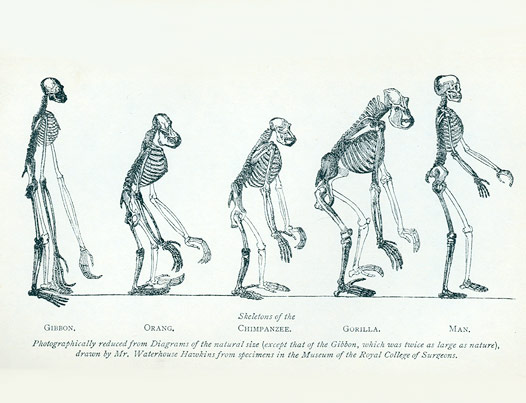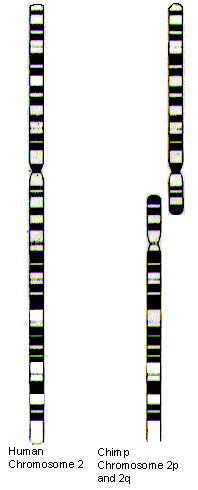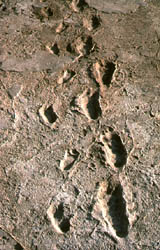Laurens
New Member
I'm aware that there are quite a few creationists on this board at the moment, so I thought perhaps some of them might like to read through this topic and attempt a rebuttal.
Firstly going by comparative anatomy we can infer that humans are closely related to the great apes (see Fig 1). In terms of genetics we are very similar to Pan troglodytes (chimpanzees) with only 1.6% difference (Diamond, 1991).

Fig 1 Great ape skeletons
There is a difference between the number of chromosomes in Homo sapiens and P. troglodytes - humans have 23 pairs of chromosomes whilst chimpanzees have 24 pairs. Now we can draw a hypothesis from this; if H. sapiens are related to P. troglodytes then we should expect to find some evidence of chromosome fusion in our lineage. If we cannot find such evidence then there is a problem with the theory that humans and chimpanzees share a recent common ancestor.
Well what we find when we analyse human chromosome 2, and chimpanzee chromosomes 2p and 2q is that our chromosome 2 is a fusion of chimpanzee chromosomes 2p and 2q - confirming the hypothesis. How do we know this? Well chromosomes have distinctive markers at each end known as 'telomeres' and a central part known as 'centromeres' - human chromosome 2 shows evidence traces of having two centromeres as well as telomeres in the middle (see Fig 2). Rather than providing a challenge to the theory that humans and chimpanzees share a common ancestor, our chromosome 2 confirms it.

Fig 2 Human chromosome 2, and chimpanzee chromosomes 2p and 2q
One of the main differences between humans and chimps is brain size (measured in cubic centimetres). Chimpanzees have a cranial capacity of 300-400 cc (Macdonald, 2009) while humans have a much larger cranial capacity of 1100-1900 cc (Wikipedia, accessed 2012). From this we can draw another simple hypothesis: If humans evolved from apes, we should find evidence of an increase in cranial capacity over time in the fossil record.
We can make cranial endocasts of fossil hominins which can be used to give a good estimate of cranial capacity (Johanson, 2006). If we plot the age of the fossils against cranial capacity on a graph, we see very clearly that there was a trend over time towards larger brains (see Fig 3):

Fig 3 A graph showing the increase in hominin cranial capacity over time
We also have genetic evidence to corroborate this. There is a gene called ASPM, which can mutate to cause microcelphaly (a disorder which causes humans to have a greatly reduced cerebral cortex), from this we can hypothesize that ASPM has something to do with the development of our uniquely large cerebral cortex. When scientists compared the ASPM gene with other species there was clear evidence that it had undergone natural selection in our lineage (because of the number of changes in the coding sequence) (Zimmer, 2005).
Another thing that we'd expect to find in the fossil record is species that show a mosaic of features between humans and apes. The most obvious example of this is Australopithecus afarensis. Who had a cranial capacity of between 375 and 550 cc (Talk Origins, accessed 2012), which is about that of a chimpanzee. Yet we know that A. afarensis could walk on two feet, like a human. This can be seen from the anatomy of their pelvic structure and their feet (Wikipedia, accessed 2012). We even have fossilized footprints of A. afarensis which show beyond doubt that they walked on two legs (see Fig 4). What we have is a chimp-like creature that walked on two legs like a human. What could this be if not a perfect example of mosaic features in an evolutionary transition?

Fig 4 Fossilized A. afarensis footprints
I have barely skimmed the surface when it comes to evidence of human evolution. I'd be interested to see if any of our creationist members have anything substantial to refute the facts I've presented in this post. I think the truth is abundantly clear, humans, just like all other life on Earth, are the product of naturalistic evolution.
References:
DIAMOND, JARED (1991), Rise and Fall of the Third Chimpanzee, Great Britain: Radius
JOHANSON, DONALD & EDGAR, BLAKE (2006), From Lucy To Language, New York: Simon & Schuster
MACDONALD, DAVID W. (2009), The Encyclopedia of Mammals, Oxford: Oxford University Press
ZIMMER, CARL (2005), The Smithsonian Intimate Guide To Human Origins, New York: Harper
Talk Origins. Hominid Species. Online. Available from: http://www.talkorigins.org/faqs/homs/species.html#afarensis [Accessed 29 February 2012]
Wikipedia. Australopithecus afarensis. Online. Available from: http://en.wikipedia.org/wiki/Australopithecus_afarensis#Skeletal_morphology_and_locomotion [Accessed 29 February 2012]
Wikipedia. Cranial capacity. Online. Available from: http://en.wikipedia.org/wiki/Cranial_capacity [Accessed 29 February 2012]
Firstly going by comparative anatomy we can infer that humans are closely related to the great apes (see Fig 1). In terms of genetics we are very similar to Pan troglodytes (chimpanzees) with only 1.6% difference (Diamond, 1991).

Fig 1 Great ape skeletons
There is a difference between the number of chromosomes in Homo sapiens and P. troglodytes - humans have 23 pairs of chromosomes whilst chimpanzees have 24 pairs. Now we can draw a hypothesis from this; if H. sapiens are related to P. troglodytes then we should expect to find some evidence of chromosome fusion in our lineage. If we cannot find such evidence then there is a problem with the theory that humans and chimpanzees share a recent common ancestor.
Well what we find when we analyse human chromosome 2, and chimpanzee chromosomes 2p and 2q is that our chromosome 2 is a fusion of chimpanzee chromosomes 2p and 2q - confirming the hypothesis. How do we know this? Well chromosomes have distinctive markers at each end known as 'telomeres' and a central part known as 'centromeres' - human chromosome 2 shows evidence traces of having two centromeres as well as telomeres in the middle (see Fig 2). Rather than providing a challenge to the theory that humans and chimpanzees share a common ancestor, our chromosome 2 confirms it.

Fig 2 Human chromosome 2, and chimpanzee chromosomes 2p and 2q
One of the main differences between humans and chimps is brain size (measured in cubic centimetres). Chimpanzees have a cranial capacity of 300-400 cc (Macdonald, 2009) while humans have a much larger cranial capacity of 1100-1900 cc (Wikipedia, accessed 2012). From this we can draw another simple hypothesis: If humans evolved from apes, we should find evidence of an increase in cranial capacity over time in the fossil record.
We can make cranial endocasts of fossil hominins which can be used to give a good estimate of cranial capacity (Johanson, 2006). If we plot the age of the fossils against cranial capacity on a graph, we see very clearly that there was a trend over time towards larger brains (see Fig 3):

Fig 3 A graph showing the increase in hominin cranial capacity over time
We also have genetic evidence to corroborate this. There is a gene called ASPM, which can mutate to cause microcelphaly (a disorder which causes humans to have a greatly reduced cerebral cortex), from this we can hypothesize that ASPM has something to do with the development of our uniquely large cerebral cortex. When scientists compared the ASPM gene with other species there was clear evidence that it had undergone natural selection in our lineage (because of the number of changes in the coding sequence) (Zimmer, 2005).
Another thing that we'd expect to find in the fossil record is species that show a mosaic of features between humans and apes. The most obvious example of this is Australopithecus afarensis. Who had a cranial capacity of between 375 and 550 cc (Talk Origins, accessed 2012), which is about that of a chimpanzee. Yet we know that A. afarensis could walk on two feet, like a human. This can be seen from the anatomy of their pelvic structure and their feet (Wikipedia, accessed 2012). We even have fossilized footprints of A. afarensis which show beyond doubt that they walked on two legs (see Fig 4). What we have is a chimp-like creature that walked on two legs like a human. What could this be if not a perfect example of mosaic features in an evolutionary transition?

Fig 4 Fossilized A. afarensis footprints
I have barely skimmed the surface when it comes to evidence of human evolution. I'd be interested to see if any of our creationist members have anything substantial to refute the facts I've presented in this post. I think the truth is abundantly clear, humans, just like all other life on Earth, are the product of naturalistic evolution.
References:
DIAMOND, JARED (1991), Rise and Fall of the Third Chimpanzee, Great Britain: Radius
JOHANSON, DONALD & EDGAR, BLAKE (2006), From Lucy To Language, New York: Simon & Schuster
MACDONALD, DAVID W. (2009), The Encyclopedia of Mammals, Oxford: Oxford University Press
ZIMMER, CARL (2005), The Smithsonian Intimate Guide To Human Origins, New York: Harper
Talk Origins. Hominid Species. Online. Available from: http://www.talkorigins.org/faqs/homs/species.html#afarensis [Accessed 29 February 2012]
Wikipedia. Australopithecus afarensis. Online. Available from: http://en.wikipedia.org/wiki/Australopithecus_afarensis#Skeletal_morphology_and_locomotion [Accessed 29 February 2012]
Wikipedia. Cranial capacity. Online. Available from: http://en.wikipedia.org/wiki/Cranial_capacity [Accessed 29 February 2012]

